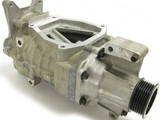HUFF AND PUFF
The principal requirement to produce power in the internal combustion engine is to combine a precise mixture of clean oxygen and fuel, then igniting this mixture.
This ignition leads to a rapid rise in temperature as the mixture burns, pressure increases rapidly and forces the piston down the bore. Hence power is produced.
The horsepower and torque output is directly proportional to the rate at which the mixture enters the combustion chamber.
In other words, It is the density (or weight) of the charge which determines the power output. Regardless of pressure, an engine responds to density.
Therefore the more mixture that can be crammed into the cylinders, the greater the potential horsepower output will be.
With conventional tuning methods we aim to improve airflow by modifying cylinder heads with large valves, camshaft profile changes coupled with multiple carburettors or fuel injection and high compression etc. etc.
There is an even more efficient tuning method!
THE SUPERCHARGER IS BACK - BETTER THAN EVER.
Forced induction is not new to the automotive world. It was used in the early 1900's and gained much respect pre WW1 with Alfa Romeo, Auto Union and Mercedes fielding Grand Prix racing cars with forced induction.
Following further development during WW2 Supercharging became a popular bolt-on kit for many vehicles. In particular the MG T-Series XPAG engine was the basis of many kits sold in the fifties.
SUPERCHARGER TYPES
There are two distinct types of mechanically driven supercharger - the blower and the compressor.
A typical blower is the Roots type where, basically, two figure eight section rotors run in opposite directions. Air is drawn in one side and blown out the other. The air passing thru' does not alter in pressure as it passes thru'. In fact the inherent heat gain causes a loss in air density. Centrifugal blowers are basically an impeller (or fan) with radial vanes spinning within a casing.
Typical of this type is the Shorrock supercharger which was a very popular bolt-on kit in the fifties and early sixties. Whilst generally more efficient than the Roots type they are particularly suited best in applications operating in a limited rev. range.
NEW GENERATION SUPERCHARGERS
Originally invented in Sweden in 1939 this twin screw design has only recently been made available in sizes to suit automotive applications. A total rethink in design and utilizing the latest extrusion, casting and manufacturing technology to provide near optimum engine efficiency.
TWIN SCREW KOMPRESSORS
are extremely efficient in both Volumetric and Adiabatic (or overall) Efficiency. The high thermodynamic performance is due to internal compression of the charge combined with very fine clearances rotor to rotor and casing to rotors.
The effect of the tight tolerances and internal compression means far less heat is generated in the intake charge. Resulting in increased density and therefore weight of charge compared with less efficient types.
The almost flat torque curve is an ideal characteristic for day to day motoring, giving outstanding engine flexibility and overall performance.
These features enable an extremely efficient compressor to be produced in a very compact package. In fact, the size of the compressor unit is the reason a BMC Mini kit was initially thought feasible.
Within the extruded light alloy casing there are two intermeshing rotors. The male and female rotors are helically cut and geared to run in sympathy without touching. Because of the relative movement of the two rotors the inlet gas is squeezed into a smaller space as it travels along the device, creating the increase in pressure. Because the rotors don't touch, the friction that plagues other superchargers is not present. Friction causes heat, a heat buildup can and does undo work performed by the supercharger. A hotter, thinner charge loses power and frictional loads mean that a higher level of engine power is required to drive the supercharger with a corresponding increase in fuel consumption.
Each Autorotor Twin Screw Supercharger Kit is engineered for a particular vehicle. There is no such thing as a universal kit which will hopefully do the job. Within the vast range of standard supercharger sizes there is bound to be one which precisely matches the particular engine requirements.








